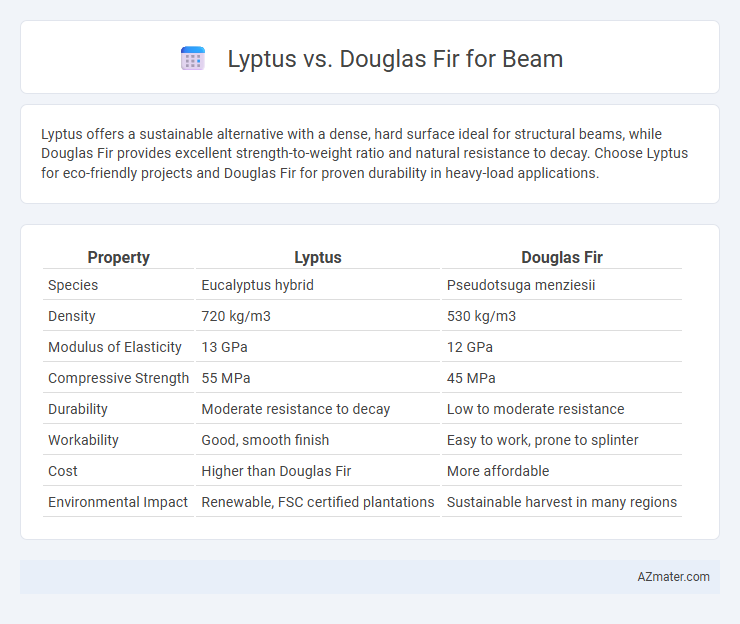Lyptus offers a sustainable alternative with a dense, hard surface ideal for structural beams, while Douglas Fir provides excellent strength-to-weight ratio and natural resistance to decay. Choose Lyptus for eco-friendly projects and Douglas Fir for proven durability in heavy-load applications.
Table of Comparison
| Property | Lyptus | Douglas Fir |
|---|---|---|
| Species | Eucalyptus hybrid | Pseudotsuga menziesii |
| Density | 720 kg/m3 | 530 kg/m3 |
| Modulus of Elasticity | 13 GPa | 12 GPa |
| Compressive Strength | 55 MPa | 45 MPa |
| Durability | Moderate resistance to decay | Low to moderate resistance |
| Workability | Good, smooth finish | Easy to work, prone to splinter |
| Cost | Higher than Douglas Fir | More affordable |
| Environmental Impact | Renewable, FSC certified plantations | Sustainable harvest in many regions |
Introduction to Lyptus and Douglas Fir as Beam Materials
Lyptus and Douglas Fir are popular beam materials known for their structural properties and aesthetic appeal. Lyptus, a hybrid Eucalyptus species, offers exceptional hardness, strength, and sustainability, making it an eco-friendly choice for beams in residential and commercial construction. Douglas Fir, valued for its high strength-to-weight ratio, durability, and consistent grain, remains a standard material in structural beams, especially in heavy timber framing and large-scale architectural projects.
Key Properties and Characteristics
Lyptus beams offer a dense, hard wood with a fine, uniform grain and natural resistance to wear, making them ideal for structural applications requiring durability and aesthetic appeal. Douglas Fir beams are prized for their high strength-to-weight ratio, excellent dimensional stability, and distinctive straight grain, which enhances load-bearing performance in construction. Both woods exhibit good workability, but Lyptus provides a more environmentally sustainable option due to its fast growth in managed plantations compared to the slower-growing Douglas Fir.
Strength and Structural Performance Comparison
Lyptus wood exhibits a similar density range of about 720-800 kg/m3 compared to Douglas Fir, which typically ranges from 530-640 kg/m3, indicating superior strength and stiffness for heavy load-bearing beams. Douglas Fir is favored in structural applications for its high strength-to-weight ratio and excellent flexibility, providing reliable performance in seismic conditions. Both species have impressive modulus of elasticity values, with Lyptus around 13-15 GPa and Douglas Fir approximately 12-14 GPa, making them strong candidates for beams requiring durability and structural integrity.
Durability and Resistance to Decay
Lyptus, a hybrid Eucalyptus species, offers impressive durability and resistance to decay due to its dense grain and natural oils, making it highly suitable for beams exposed to moisture and pests. Douglas Fir, known for its strength and moderate decay resistance, requires treatment or protective finishes when used in environments prone to rot or insect damage. Comparing both, Lyptus generally outperforms Douglas Fir in decay resistance, though Douglas Fir remains a popular choice for structural applications due to its availability and cost-effectiveness.
Sustainability and Environmental Impact
Lyptus timber, derived from fast-growing Eucalyptus trees cultivated in sustainably managed plantations, offers a renewable and responsible alternative to traditional wood sources. Douglas Fir, while known for its strength and durability, often involves longer growth cycles and harvesting from natural forests, which can lead to greater environmental disruption. Selecting Lyptus beams reduces carbon footprint and supports reforestation efforts, making it a more sustainable choice for environmentally conscious construction projects.
Workability and Ease of Fabrication
Lyptus offers superior workability due to its fine, uniform grain and consistent density, making it easier to machine, cut, and shape compared to Douglas Fir. Douglas Fir's coarse grain and variable density can cause uneven cuts and increase tool wear, requiring more effort during fabrication. Both woods respond well to standard woodworking tools, but Lyptus reduces processing time and enhances precision in beam manufacturing.
Cost and Availability Analysis
Lyptus wood often presents a higher initial cost compared to Douglas Fir, primarily due to its limited sourcing and sustainable harvesting methods. Douglas Fir is widely available across North America, resulting in lower pricing and easier procurement for large-scale beam projects. Cost efficiency and consistent supply make Douglas Fir a preferred choice for construction requiring structural beams, while Lyptus appeals to niche markets emphasizing eco-friendly materials.
Aesthetic Qualities and Visual Appeal
Lyptus offers a smooth, consistent grain with a warm reddish-brown hue, providing a modern and uniform aesthetic ideal for sleek beam applications. Douglas Fir features pronounced grain patterns and a lighter, golden tone that lends a rustic, natural charm favored in traditional or exposed beam designs. The choice between Lyptus and Douglas Fir hinges on desired visual impact, from contemporary elegance to classic warmth.
Best Applications for Each Wood Type
Lyptus offers superior hardness and resistance to wear, making it ideal for structural beams in high-traffic areas or load-bearing applications requiring durability. Douglas Fir's excellent strength-to-weight ratio and natural resin content provide exceptional stability and resistance to moisture, suited for outdoor beams, roof trusses, and heavy construction projects. Choosing Lyptus is best for indoor exposed beams with aesthetic appeal, while Douglas Fir excels in exterior framing and long-span beam applications.
Conclusion: Choosing the Right Beam Material
Lyptus offers a sustainable and fast-growing alternative to traditional Douglas Fir, featuring a dense grain that provides strong structural integrity ideal for beams. Douglas Fir remains a preferred choice due to its proven durability, wider availability, and familiar workability in construction projects. Selecting the right beam material depends on balancing environmental considerations with load-bearing requirements and long-term performance expectations.

Infographic: Lyptus vs Douglas Fir for Beam
 azmater.com
azmater.com